This is a compilation of the designer diary entries posted in the Wingspan Facebook group. They are listed here in chronological order, with the most recent entry at the top.
***
December 31 (Elizabeth)
Some folks have asked if I would share more of the development story of Wingspan. Today I’ll tell you about how the engine-building. Because the story of the development of Wingspan is mostly the story of finding a way to make the game feel like it really builds as you’re playing it.
The very first version of the design was quite different: it was more of a play-a-card, draw-a-card game that focused on racing to get 8 birds out on the table by collecting the right food. This was a fine start, as it helped me think through how the economics of being a bird might play out in a card game. But there was no arc to the gameplay: your turns at the end of the game were very similar to your turns at the beginning of the game.
Many of the intermediate engine-building versions of Wingspan were based around paying to improve your park: you’d discard food or bird cards to improve habitats, start nesting programs, etc, and that would make you better at getting more food or birds. This was thematic, but it was more about running the park than playing with the birds. The boosts to your abilities were finite: you had to go and pay for another improvement to get better again.
There were two breakthroughs that moved things to another level. One was the idea of the player mat that automatically made your actions more powerful as you added bird cards to it. The second was the idea that the bird cards could make your turns more powerful not just by moving you up the player mat, but by triggering their own powers.
It really came down to solving the to one fundamental question: how could players feel more and more powerful, while keeping the focus entirely on the birds? And with these two changes, I had it: a strong, continuous build, that was based solely on how you play your bird cards. It still took a lot more elbow grease to hammer out the details, but I was pretty sure it would get there.
Do you think about the arc or the building-up of games when you’re playing them? What are some of your favorite engine-building games?
December 14
What are the first few choices made by each player in the game? This is always a design puzzle for me, because I want to ease players into the game (unlike a draft right from the start, which can be overwhelming, especially for new players), but I still want them to be able to make interesting decisions early on.
For a significant part of Wingspan’s design, the setup worked something like this: Each player received 5 bird cards. They picked 2, discarded the others, and gained 1 food token of their choice.
The intent behind this is that we wanted to give players a head start without devaluing any of the actions. However, it sometimes made the start a little too slow, and it could result in making players feel unlucky if they weren’t getting the food they needed (an issue we also addressed with different ways to reroll the dice and an optional 2:1 conversion when playing birds).
We considered a few different options, and then we stumbled upon something that ended up sticking. It works like this:
During setup, each player receives 5 bird cards and 1 of each food token (5 total). So you have a total of 10 things, right? Okay, choose 5 of those things and discard the rest.
That’s it. I’ve found that it’s a really fun choice, because you have full agency in that moment. When I’m teaching the game, I take this opportunity to explain that you must pay food to play a bird card, and usually one of the first things you’ll do in the game is play a bird, so you’ll want to choose a bird and the corresponding food for that bird.
But you’re not required to do that. You could keep all 5 birds if you want and discard all 5 food tokens, or vice versa. Or 4/1 or 3/2. It’s your choice. It’s not too limiting, but it’s also not so open that you can just do whatever you want.
I love this decision, and I look forward to seeing which birds and food you keep when you start playing Wingspan in January.
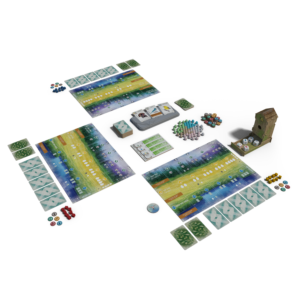
December 11
December 10
You may already feel like you know how to play Wingspan, but if you want the full rules, they’re now available for you to download and read.
There are 3 rulebooks in Wingspan: A core rulebook with full details and examples, an Appendix featuring a quick-reference guide containing all birds, bonuses, and goals, and the Automa rulebook for solo play. The versions posted online are all low-res; otherwise the files are huge.
At its core, Wingspan boils down to 4 actions. So we’re actually able to teach you the entire game on a single page. If you’re interested in that, turn to the second page of the Appendix–the quick-reference guide explains the entire game.
I’ll eventually post rulebooks in other languages after our localization partners have all announced the game.
Also, Rodney at Watch It Played is working on a rules replacement video that should be available before January 2. January 2 is also the day that advance reviewers will be allowed to share their opinions about the game.
If you have any questions about the rules, please let me know!
December 9
Other than the scorepad, first-player token, rulebook, and Appendix, I think you’ve now seen all of the components in Wingspan, so today I’d just like to share some of the beautiful photos Kim Euker took of the game.
Usually I take photos of our games for the website and BoardGameGeek, but I’m not a photographer, and I tend to insert my cats into every photo (well, they insert themselves, and I delight in it). So this time I sent one of the advance copies to Kim, a Stonemaier ambassador and professional photographer. (She also has a cat, shown in the last photo.)
Kim set up the game on her table and took a number of photos, some of which you’ll see here. We had a little confusion about the use of the 4 clear plastic resource containers–they’re used to hold and store the food and egg tokens (the blue tray is meant to store the cards, not tokens).
What else would you like to see in these previews? I was thinking over the next two days I could make an unboxing video and then reveal the rulebooks, and then we could spend the rest of the week discussing the contents. If there’s anything else you’d like to see, please let me know!
December 8
What’s that mysterious little mat in the middle of the table?
Yesterday I mentioned the concept of end-of-round goals. In addition to the bonus cards, these are another way that the game gives you a little bit if guidance (if you want it).
During setup, you choose one side of the goal mat. We playtest two different versions of it, and different playtesters enjoyed different versions, so we decided to include both. The green side is the default, as it features indirect player interaction, while the blue side is better for new players (it only requires you to pay attention to what you have, not what others are doing).
You then randomly select 4 out of the 8 double-sided goal tiles and place them in a random order on the mat. They’re designed to avoid redundancy or imbalance–for example, one side of a tile might say “# of birds in your wetland habitat” and the flip side says “# of eggs in your wetland habitat.”
The goals are all visible from the beginning of the game in case you want to plan a long-term strategy, but the only goal that scores each round is the current goal. For example, in the photos here, the round 1 goal refers to the # of birds with specific nest type that have any number of eggs on them. After you score that goal at the end of round 1, you don’t have to think about it anymore.
Because the cubes are also used as action tokens (see yesterday’s post), each player MUST score every goal, even if they score 0.
A decent score in Wingspan is in the 70s, so the points on these goals can add up. For example, in the game we played on Wednesday, my friend Mira focused heavily on the goals after round 1, accumulating 14 points as a result. She ended up winning with 84 points.
Based on the mechanisms you’ve seen in Wingspan (and you’ve seen most of them at this point) and what you know about yourself as a gamer, what are the chances you’ll win your first game?
December 7
In a previous post, I talked about what a turn looks like in Wingspan: You either play a bird, gain food, lay eggs, or draw bird cards (and, if applicable, activate birds in the corresponding habitat). But how many turns do you get? When does the game end?
The classic Stonemaier method is that turns happen one after another uninterrupted by rounds, maintaining a seamless flow until the end game is triggered. We tried this with Wingspan for a LONG time, with the end-game trigger usually connected to the number of birds played. But what we found is that the game felt like a race to X birds, and it was suffering as a result. Players didn’t feel like they had time to pick and choose the birds they really wanted for their engine, nor did they feel like they could run their engine. They were just playing birds as early and often as possible.
So we tried something new: We changed the structure to 4 rounds (it may have been more at some point, but the final version has 4 rounds), giving each player a set number of actions each round. This change made an instant, positive impact in the game.
We kept the end-of-round steps very simple: You just remove your action tokens from your player mat, wipe the bird mat clean, pass the first-player marker, and score the end-of-round goal (which I’ll discuss tomorrow). When you score the goal for that round, you must take one of your action tokens and place it on the goal mat, which decreases the number of actions you have the following round. Thus you have 8 actions the first round, then 7, 6, and 5.
The reason for this is that as your engine grows, your turns become more and more powerful. We want players to feel powerful, but we don’t want them to be able to do everything–we want their choices to matter throughout the game. Also, this ensures that the game doesn’t overstay its welcome, as turns take longer in round 4 than in round 1.
While today’s featured component–the action cubes–aren’t particularly sexy, they’re very helpful for tracking the number of actions you have and ensuring that you trigger all of your activated abilities whenever you choose an action.
December 6
With such a wealth of options in Wingspan, we wanted to give players a few beacons to help guide them as they make choices about which birds to draw and play (and where to play them). One example of this is the set of 26 bonus cards.
Each player gets 2 bonus cards at the beginning of the game; they choose 1 to keep, and they discard the other. There are also some birds with “when played” abilities that let you draw 2 more bonus cards (keep 1, discard 1).
I really admire the creativity that Elizabeth put into the bonus cards. They represent people who are checking out your aviary; if they’re impressed, you get some victory points at the end of the game. For example, the Rodentologist gives you 2 VP for every bird on your player mat at the end of the game with a mouse on it (the food preferred by that bird). Others look at the habitats or nests of the birds, their victory points, or even your end-game hand size (which otherwise doesn’t matter).
A few of the most creative bonus cards ended up giving our localization partners some trouble. For example, the Photographer gives you victory points for the number of birds with colors in their names. This is fun to keep an eye out for in English (bird names are delightful), but these birds have other names in other languages. So our localization partners had to make some adjustments and/or replacements for some of the bonus cards.
Also, the name of these cards (“bonus cards”) was also a bit of a puzzle to figure out during development. For a while they were called “goal cards,” and we found that people were focusing way too much on them despite the relatively small number of points they provide (a normal end-game score is in the 70s). They’re helpful, but not worth getting frustrated over if the birds you need just happen to not show up on the bird mat. So we softened the name to “bonus cards,” and the problem went away.
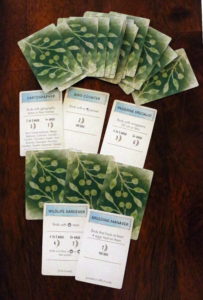
December 5
Player mats: These are where most of the action takes place in Wingspan. Quite literally, actually: On your turn, you select one of the four actions on your player mat. You take the action, and play progresses clockwise.
Like in other Stonemaier Games, we like to keep the core action system very simple. However, Wingspan adds several layers of complexity that increase throughout the game as you build your engine, as each habitat on your player mat is linked to a specific action.
Both layers are linked to the bird cards and where you play them. The more birds you play in a habitat, the more powerful that habitat becomes for you on future actions (though there are egg costs to playing bird cards in columns 2-5). Also, many of the birds in Wingspan have “when activated” abilities that I get to use every time I choose the habitat in which I played those birds.
This adds up to a huge amount of progression over the course of the game, with players chaining together birds and improving their core actions as they play. This is probably the biggest difference between the original version of the game and the final version–it evolved quite a bit over the last few years.
The player mats are huge and sturdy, and they each fold down the middle (the outside is designed to look like a leather field guide). Beth Sobel is responsible for the player mat art.
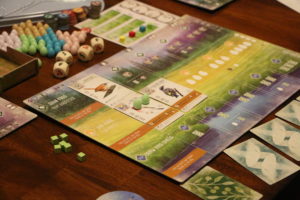
December 4
The Automa system uses cards to simulate an intelligent opponent (without requiring all the upkeep of actually taking turns for a player who isn’t there). Wingspan’s Automa includes a separate rulebook and a total of 16 cards, my favorite of which is the cleverly named “Automubon expert-level” card.
Last, if you’re curious about people play games solo (and why publishers are including solo modes more often), Morten has a great writeup about it here.
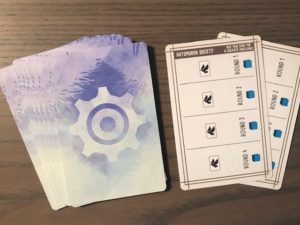
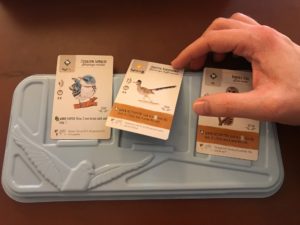
December 2
It’s time to show you some bird cards! Some of the other components I want to show you won’t make sense without these as context (though a lot of these abilities won’t make sense yet…we’ll get there).
Wingspan includes 170 uniquely illustrated bird cards, each with a different ability. This is one of the biggest reasons I compare it to Terraforming Mars–there’s so much variety in these cards, and they’ve led to very different strategies and engines each time I’ve played.
My favorite bird is the peregrine falcon, so I was elated that Elizabeth chose to include it (it ended up becoming the code name for the game). What’s your favorite bird?
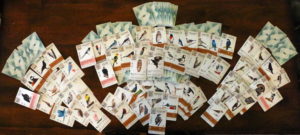
December 1
Today I’d like to share one of my favorite components in Wingspan and how it fits mechanically into the game: the birdfeeder dice tower.
Sometime during the design process, Elizabeth shipped a prototype to me that contained a very early version of the dice tower–no art, just carefully constructed foamcore. It was an instant hit during playtests, as it fit thematically with the game and was just satisfying to use.
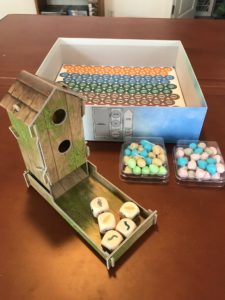
5 Comments on “Design Diary – Wingspan”
Leave a Comment
If you ask a question about a specific card or ability, please type the exact text in your comment to help facilitate a speedy and precise answer.
Your comment may take a few minutes to publish. Antagonistic, rude, or degrading comments will be removed. Thank you.
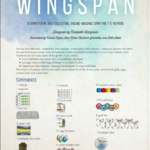
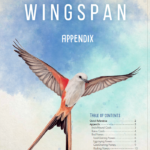

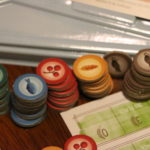
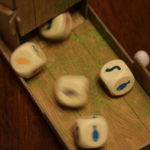
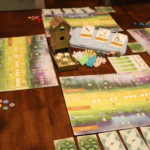
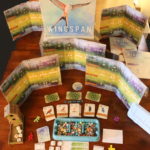
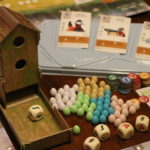
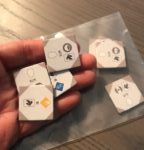
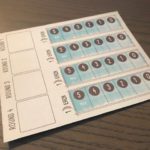
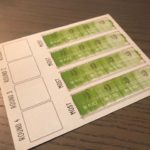
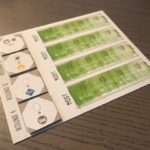
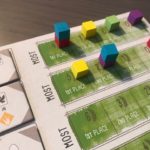
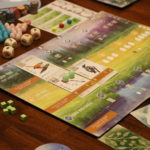
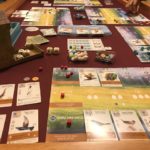
[…] tower didn’t start out as a cardboard prototype. Instead, the designer (Elizabeth Hargrave) created a prototype out of foamcore. This is a type of board that has paper on the outside and polystyrene or similar material on the […]
Where is your “how to play video” ? I typed in all the stuff and can’t find it. I’m 65 and very much NOT a technical wizard. My hobby is blacksmithing….. no electrons or dotcoms. Help please.
Here’s the “How To Play” video. :)
https://youtu.be/lgDgcLI2B0U
I love this game! I’d like to recommend a revision to the order of operations on the scoresheet- to allow a logical take down of the game while scoring: bonuses, end of round pts., eggs, cached food, then birds and finally tucked cards. That way you can work top to bottom through the pile more easily.
You need a poster for sale to enthusiasts!!
SB